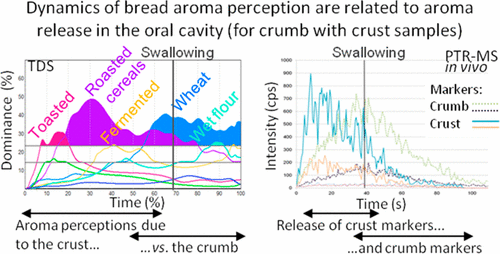Why a crackly crust is essential to a baguette's aroma and taste

An authentic French baguette is one of those key staples that foodies hunt for. Now scientists have gained new insight into why a crisp crust is a must for this quintessential bread. They report their findings on how crumb and crust structure affect aroma—and therefore, perceived taste—in ACS' Journal of Agricultural and Food Chemistry.
The smell of baked bread that's fresh out of the oven is mouth-watering, but the effect of aroma doesn't stop there. Chewing food also releases molecules that waft in our mouths, interacts with olfactory receptors and influence how we perceive what we're eating. Understanding this dynamic could help food scientists improve the taste of products. Taking the baguette as an example to explore this possibility, Anne Saint-Eve and colleagues wanted to see how its texture would affect its aroma when chewed.
The researchers had three study participants eat samples of nine baguettes, each with different crumb and crust densities, water content and elasticity. An analysis of volatile organic compounds that are exhaled through the "nose spaces" of the participants along with their chewing activity showed that firm bread and brittle crust led to more chewing and a greater rate of release of aroma molecules. The findings could help food scientists create new bread types better tailored to meet consumers' expectations, the researchers say.
The authors acknowledge funding from Lesaffre International.
More information: Solenne Jourdren et al. Effect of Bread Crumb and Crust Structure on the in Vivo Release of Volatiles and the Dynamics of Aroma Perception, Journal of Agricultural and Food Chemistry (2017). DOI: 10.1021/acs.jafc.7b00287
Abstract
This study examined the effects of bread crumb and crust structure on volatile release and aroma perception during oral processing. French baguettes with different crumb structures were procured from a supermarket or local bakeries (n = 6) or produced in the laboratory via par baking (n = 3). Eight study participants consumed crumb-only and crumb-and-crust samples, and the resulting volatile release was measured in vivo using proton transfer reaction-mass spectrometry. A statistical model was then used to examine the contributions of volatile compounds to target ion production (i.e., crumb or crust markers). Utilizing the three laboratory-produced breads, chewing behavior and aroma perception were measured via electromyography and the temporal dominance of sensations method, respectively. The results revealed that the initial levels of crumb markers as well as crumb firmness affected the crumb markers release. Crust markers were released more quickly than crumb markers, leading to different perception dynamics
Journal information: Journal of Agricultural and Food Chemistry
Provided by American Chemical Society



















